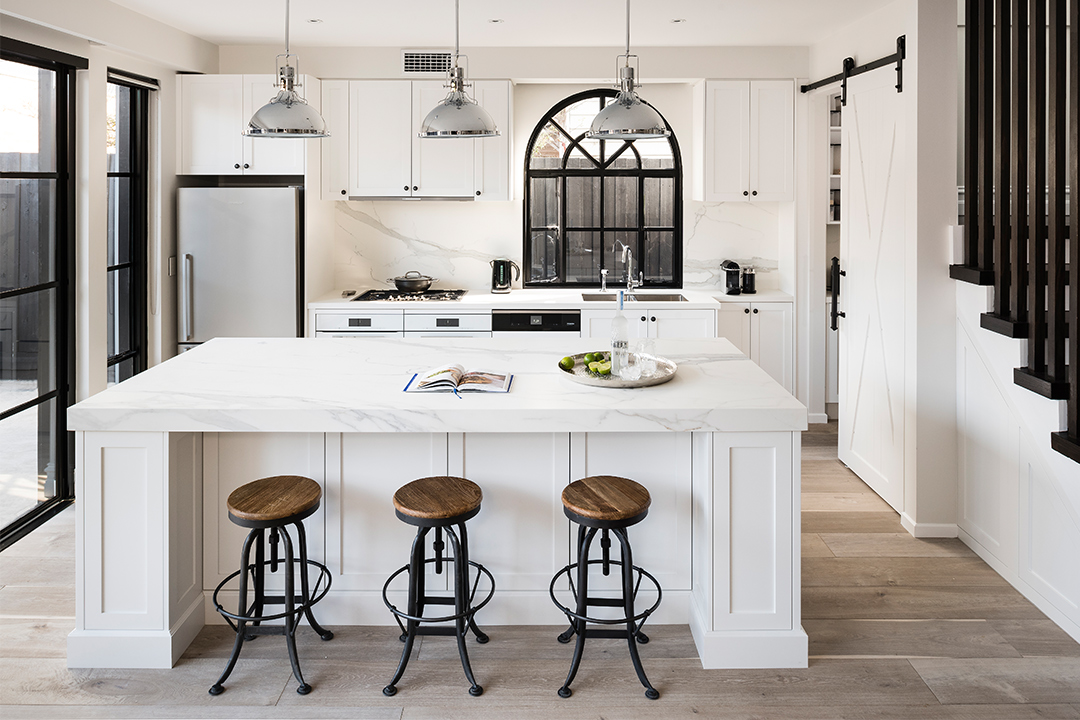
THE RETURN OF THE CURVE
From 1920s art deco to the ever-timeless shaker style, it’s clear that many modern trends are ones that have been revived and refreshed from earlier times. Among these trends, designers have started plucking the curved kitchen out of the mid-century and inserting it into today’s homes, taking a new spin on unconventionally shaped benches and cabinetry. Kirrily Ireland gets the latest insights into this returning feature from the wonderful Jane Smith, designer at Smith & Smith Kitchens.
Written by Kirrily Ireland.
EMBRACE THOSE CURVES
No longer a thing of the past, homeowners and designers alike are once again looking to softer lines, rounded features and contoured elements within the kitchen. “For many years we have seen sharp angles in kitchen design and now our clients are ready for a deviation from that and have desired the introduction of a curve here and there to warm things up and make it a little more inviting,” Smith says. Even a subtle inclusion can help alleviate the harshness that’s often associated with angles and sharp corners, giving the overall space a homelier, more welcoming atmosphere.
Because they take their inspiration from the past, curved kitchens work well in a variety of homes, having evolved to suit both classic and contemporary. Depending on the kind of kitchen you have, these curves will be implemented in slightly different – although nevertheless stylish – ways to complement the rest of the home. A traditional house may benefit from the grandeur of a curved island bench, while a modern dwelling will accommodate either subtle curves throughout, or one large, rounded feature, in keeping with the pared-back, minimalist approach that’s synonymous with newer dwellings.
Curved kitchens also come with hidden practical benefits that go beyond their fashionable appearance. By eliminating or reducing corners, the space will become more ergonomic and people-friendly. Whether you have small children running around the house or a tight kitchen that’s tricky to navigate, curved benches will save you and your family from a bump on the head or the hips.


KEEP IT TRENDY AND BENDY
Kitchens with curves generally conjure up images of statement benches and benchtops, however if that’s not the direction you’re going for, Smith assures readers that “curves can be produced anywhere in the kitchen”. “In contrast to bold lines, a curve becomes a focal point and it really depends on where you want that focal point to appear.” The designer lists windows, shelves, mantles, pedestals below benchtops, and glazed doors as some of the areas where a curve can be incorporated. Where the pedestals and cabinetry provide an opportunity to achieve a stronger curve, in comparison arched windows, rounded taps, and curved detailing along a rangehood or shelf evoke a sense of simplicity while still contributing a softness to offset cold, straight lines.
Having a combination of curves and straighter edges is often a go-to choice among designers. “Curves in combination with stretches of straight lines are very much on trend,” Smith affirms. “A straight row of cabinetry that concludes in a curve is one of the ways we draw curves into a kitchen. A curve to a benchtop over a straight set of base cabinets is [another] lovely way of softening a straight line.” The blending of the two will ensure you’re not overdoing it either way – it’s all about achieving balance.
If you don’t want to include curved features in your new kitchen itself, or go to the trouble to modify your existing one, there are other ways of introducing them into the space. This could be a round dining table or stools under a straight-edged bench. “Curves provide an inviting element to kitchens that draws people in. Having curves in the kitchen alongside a dining or family area ties softer furnishing in and unifies the space.”

CURVES OF CONTRAST
Often curved benches and cabinetry require a bit of engineering to take on this specific shape. The effect will vary depending on the type of materials used to create your shapely kitchen. “Laminate and painted kitchensaccept curves very well,” Smith says. “Benchtops in stone or manmade products are also well adapted to create curves and our designers are adept at bringing in curves to fit with our client’s budgets and wishes.”

While “curving cabinetry and benchtops can be time consuming and therefore increase the price of your kitchen”, consulting a company that’s capable of sticking to your budget and finding creative ways of implementing curves without overspending will make including this fabulous design tool possible. Businesses like Smith & Smith Kitchens who manufacture their own materials are worth considering, as they are able to offer lower prices by cutting out the middleman.
Specific materials will also influence colour and contrast, which are “two ways that curves can be made a feature in a kitchen”. “If the curve is in a contrasting colour, it will demand attention and the feel of that curve will filter down to the rest of the kitchen even if there are no other curves. Contrasting textures can also demand attention – [for example], if the curve is in a pedestal of an island bench, clad the curve with slats [so] the texture and the curve combine to create a wonderful focal point.”
Offering a point of interest, “there is something about a curved benchtop that is begging to be touched”. As the expert attests, “the tactile nature of curves is part of their appeal because they draw the eye and provide a beautiful finish”. It’s no wonder why more and more homeowners are curving away from the straight and simple to explore the returning world of freeform statements, refined arches and perfectly rounded features.
